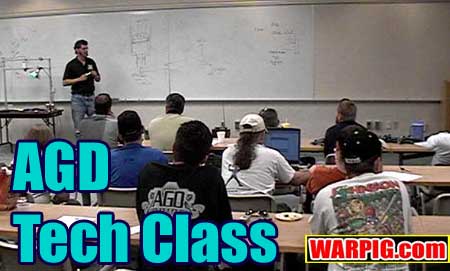  |
|
|
|
|
|
|
  |
|
|
|
|
|
|

What
do you think?
|

Airgun Designs Tech Class by Bill Mills As a pre-event to the 2003 DraXxus International Amateur Open, AirGun Designs hosted the 2003 AGD Tech Class. In the mid 1990s, AGD and Worr Game Products were the two companies in paintball providing airsmith training for their products. AGD’s tech class was held at their facility near Chicago Illinois. After a break of a few years with no training, AGD teamed up with WGP and other groups to provide a series of seminars together, and eventually settled on training before the IAO, as the tie in to a major tournament and industry conference made travel easier for shop owners, airsmiths and Automag enthusiasts.
After lunch, the class went into new areas, including what the company is currently developing, the ULE trigger. ULE stands for Ultra Light Engineering, and has been applied to some of AGD’s newer products including the ULE body and valve body, which are slim, lightweight aluminum components that replace the company’s earlier stainless steel models. Up until Airgun Designs released the Level 10 bolt kit, bolt pressure was a major factor determining the weight of the trigger pull in their mechanical guns. The Level 10 bolt kit uses a similar concept of varying piston diameters to greatly reduce the forward force of the Automag’s bolt, to the point that it is light enough to back off of a misfed paintball rather than chopping it. With the bolt force taken out of the trigger equation, AGD concentrated on the other item that effects trigger pull – the on/off valve.
During the discussion, Kaye talked about the parts in the ULE trigger assembly, down to the micro o-ring that was small enough to seal against the very slender pin. That o-ring is made of black rubber. “Sure, we’d prefer to use a urathane o-ring there, but they don’t make them that small,” he said. Kaye explained that with proper installation and adjustment the Level 10 bolt combined with the ULE trigger assembly yielded a trigger pull as light or lighter than many electronic paintguns on an Automag with no electronics, and still having the benefits of a reactive trigger. It was Level 10 bolt that made the ULE trigger possible, Kaye said, because the lighter bolt pressure meant it was possible to use the new valve that pushed back on the sear with less force. The ULE trigger assembly was not slated for display or release at the Amateur Open, or available to dealers, but rather was supplied to the students trained in the tech class. AirGun Designs decided to use the techs who were newly and properly trained in the installation and operation of the new valve assembly to serve as its field testers. The company would then move forward with design changes or product release based on the feedback from that group.
|
| Copyright © 1992-2019
Corinthian Media Services. WARPIG's webmasters can be reached through our feedback form. All articles and images are copyrighted and may not be redistributed without the written permission of their original creators and Corinthian Media Services. The WARPIG paintball page is a collection of information and pointers to sources from around the internet and other locations. As such, Corinthian Media Services makes no claims to the trustworthiness or reliability of said information. The information contained in, and referenced by WARPIG, should not be used as a substitute for safety information from trained professionals in the paintball industry. |